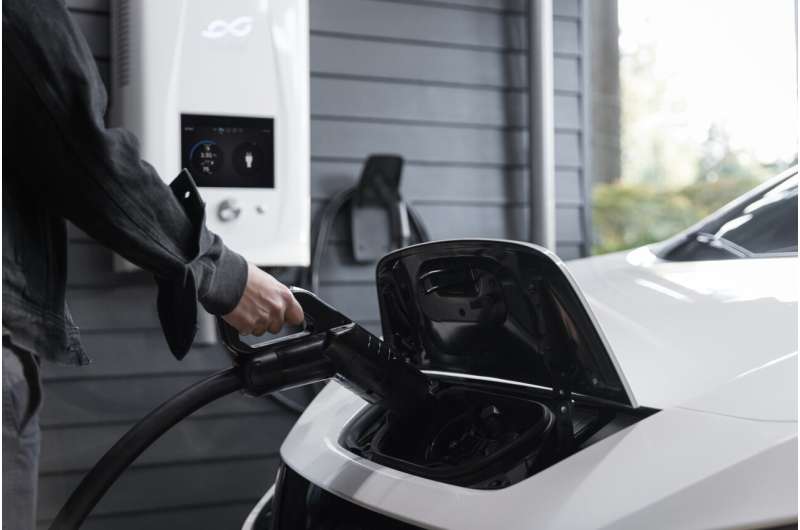At a nondescript office park in the Mira Mesa neighborhood of San Diego sit a pair of nondescript cubes, adjacent to a nondescript library annex that houses old books, papers and other items from UC San Diego.
But something different is happening. Inside each cube sits a collection of used electric vehicle batteries—one containing Tesla batteries and the other stocked with old batteries from Nissan Leafs.
While these lithium-ion batteries once powered cars that are no longer on the road, they still have plenty of lifespan left in them. A local company with connections to the university has taken what would usually be discarded and found a novel way to reuse them.
Mike Ferry, president of Smartville, Inc., points to the building’s roof.
“You can’t see it, but there’s a huge rooftop solar array up there and that array overproduces (electricity) during the day,” Ferry said on a hot, sunny day last week. “We’re now taking that excess and during the critical peak (time for California’s grid), from 4 to 9 p.m. when the sun goes down, we discharge that energy back into the library and we power the building.”
It sounds simple and while other companies are working with repurposed batteries, the Smartville energy storage system—called MOAB—combines two different battery packs into a single system.
“That’s never been done before,” Ferry said. “Our technology is able to integrate battery packs, not only in different states of health and different histories but actually from different manufacturers (Tesla and Nissan) and control them in a reliable way.”
MOAB originally stood for Modular Assembly Battery system but is now the trademarked brand name for Smartville’s technology.
The system also collects data that can predict precisely how long the batteries are going to last.
“This is energy storage that’s using batteries that otherwise are going to be wasted,” said Antoni Tong, Smartville’s CEO. “So there are huge social and environmental implications.”
In addition to supplying power to the annex between 4 to 9 p.m., MOAB also can provide emergency backup during power outages.
The warehouse holds a collection of books, physical items and even manuscripts from Jonas Salk, developer of one of the first polio vaccines and founder of the Salk Institute for Biological Studies in La Jolla.
The archives require constant humidity and temperature controls to avoid damage. The new energy storage system can provide the annex up to 48 hours of electricity if a blackout or energy emergency cuts off the building’s power.
“I have a sneaking suspicion that results of this ongoing research will end up in our collections, possibly even within this very warehouse and help to drive future innovations,” Jason Schulz, UC San Diego’s Director for Library Services, said during the project’s unveiling last Wednesday.
The MOAB system in Mira Mesa is relatively small—just 500 kilowatt-hours, or one-half a megawatt-hour. For comparison, SDG&E’s Kearny Energy Storage battery facility delivers 80-megawatt-hours of energy via batteries housed in 126 cubes.
Smartville has garnered $9 million in funding to develop its system, which has been enough to cover the company’s budget and payroll for 15 employees who work at Smartville’s headquarters in Carlsbad. The company has received money from the U.S. Department of Energy and two grants of $2 million each from the California Energy Commission.
“This project is filling a very important kind of hole in the mosaic” for California to achieve its clean energy goals, said energy commission chair David Hochschild. Reusing EV batteries for energy storage is “exactly what the state needs.”
More MOAB systems are in the pipeline—a 1 to 4 megawatt-hours project in Fresno; a 0.25 megawatt-hour system at Nissan’s U.S. headquarters in Franklin, Tenn.; and another 0.25 MWh project in Atlanta with Southern Power. Smartville also has a small demonstration project in Chula Vista.
Storage has taken on a higher profile in recent years, especially in California, as the state increasingly relies on renewable energy sources.
Production from solar and wind has ramped up but they are intermittent.
Solar production may be abundant during the day but practically vanishes after sunset or when smoke and clouds obscure the skies. And when breezes flag, production from wind farms peters out. Natural gas can help fill the gap but it’s a fossil fuel and California has set a target to derive 100 percent of its electricity from sources that don’t emit carbon by 2045.
Energy storage is seen as a difference-maker, storing up solar power during the day and discharging electricity later, when California’s power system needs need it.
In 2019, only about 200 megawatts of storage could be found on California’s grid. This year, the numbers have grown to about 3,600 MW and the energy commission projects that 49,000 MW of battery storage will be needed to meet California’s 2045 target.
Battery storage has its critics, who say the systems are more expensive than conventional energy sources and doubt whether battery projects can scale to the orders of magnitude and hours of duration required to meet decarbonization targets. Fires have also broken out at some battery storage facilities.
“It’s all about applications,” Tong said. “There’s technology in the pipeline and it’s also within the capability of the solution we are providing here. Each of the (MOAB cubes) are about a quarter-megawatt-hour in size but when you daisy-chain them, they can provide a longer duration of discharge. And with the projection of cost reductions, we can fill that market as well.”
In addition to being Smartville’s CEO, Tong is a research scientist at UC San Diego. Ferry is also the director of Energy Storage & Systems at the university’s Center for Energy Research. UC San Diego has an equity stake in Smartville, Inc.

